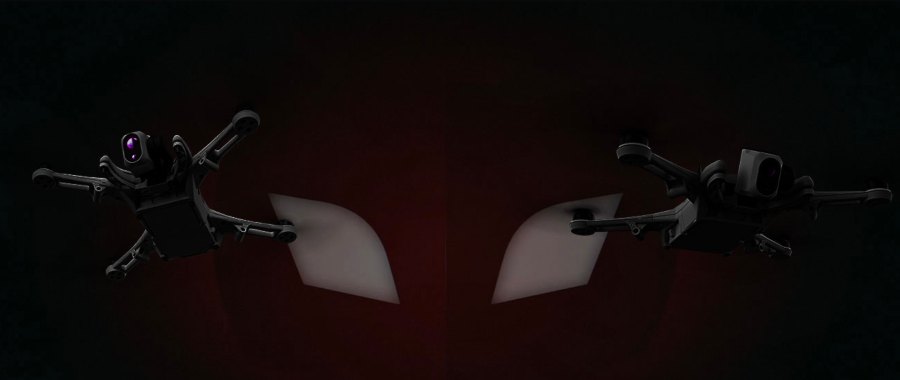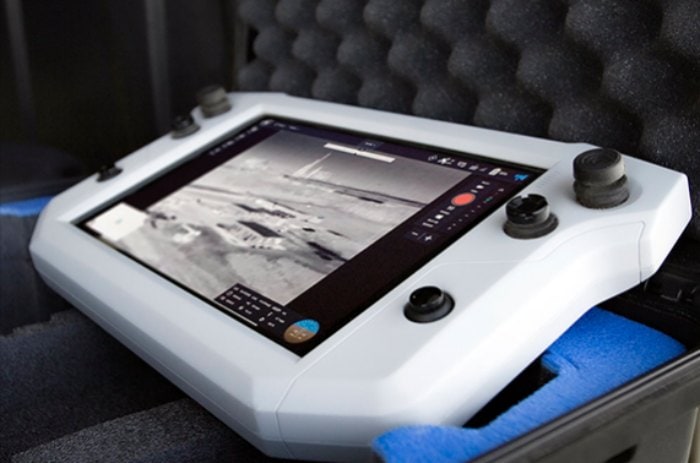New Low-Light Camera Makes It Possible to Fly Drones at Night—Without Anti-Collision Lights
BY Zacc Dukowitz
25 January 2023There are a lot of reasons you might want to fly a drone at night.
Aerial cinematography comes to mind, as does surveillance and security. (Or, if you’re Reuben Wu, creating art using drones as a light source.)

Credit: Reuben Wu
Typically, nighttime drone ops require the use of anti-collision lights so other aircraft can see it.
Since 2021, when the FAA made it possible to get instantaneous night flying approvals via LAANC, night flying has become much more accessible than it used to be. Yet despite it being easier to fly at night, camera technology still limits the actual usefulness of night flying.
Most cameras that come with a drone can’t take good pictures or video at night. As visibility diminishes, so too does the quality of images you can get, as well as the ability of a drones’ obstacle avoidance system to navigate its environment.
But a new partnership between Teal Drones and Canada-based optical products manufacturer Immervision could radically improve the prospects for night flying.

Credit: Teal Drones
At CES in Las Vegas this month, the two companies announced that they had teamed up to make a cutting edge low-light camera for the Teal Drones Golden Eagle.
The partnership is a play to strengthen Teal’s offerings for military and defense applications.
Because most military operations happen at night, having a low-light solution is a key capability . . . Between this new development and other nighttime-focused capabilities on the horizon, Teal’s new model will be the go-to small drone [for] defense and security forces.
– CEO Jeff Thompson, CEO of Red Cat Holdings
Both Teal Drones and Immervision are already well positioned to sell to the Armed Forces, since both companies are on the Pentagon’s Blue UAS list, a designation that means their technology has been approved for use by the federal government.
The Golden Eagle’s New Low-Light Capabilities
Teal’s Blue UAS designation has helped the company sell its Golden Eagle drone to federal agencies, perhaps most notably in a recent contract worth about one million dollars with the U.S. Border Patrol.
The Border Patrol plans to use drones to surveil the U.S. border—and being able to do this work at night would be a huge plus.
Enter the new camera made by Teal Drones and Immervision, which was made to support night surveillance.
The lens is designed to maximize the concentration of light per pixel on the image sensor to provide the best image quality in low-light conditions, across the complete field of view. Our camera module . . . is capable of seeing objects in a dark environment at 1 lux, which is equivalent to deep twilight.
– Jean-Sébastien Landry, Director of Product Management at Immervision
According to Ryan Kier of Teal Drones, independent testing found that Immervision’s low-light camera was “easily two times better than the nearest competitor.”


Credit: Teal Drones
The next model of the Golden Eagle will be equipped with Immervision’s low-light camera technology, featuring two low-light camera modules.
In addition to flying at night, the cameras will help the drone fly better in other low-light scenarios, including heavy fog, inside caves, or underneath bridges.
These cameras will help not only to enhance the images and video the drone can collect at night, but also to improve the drone’s autonomous navigation. By integrating the Immervision cameras with Teal’s navigational software, the Golden Eagle will now have:
- Low-light obstacle avoidance
- Low-light autonomous take-off-and-landing
- Automatic creation of and self-location on a 3D map without access to a GPS signal
The last item is significant.
With the two low-light camera’s, the Golden Eagle will be equipped with stereoscopic vision, allowing it to make a 3D map as it flies and locate itself on the map, even in GPS-denied locations and environments.
Red Cat Holdings’ Defense-Focused Future
Red Cat Holdings is the parent company of Teal Drones.
Over the last few years Red Cat has gone on an acquisition spree, buying up drone companies like Fat Shark, Rotor Riot, Skypersonic, Drone Box, and, of course, Teal Drones.


Credit: Teal Drones
But just two months ago the company decided to get rid of its consumer-focused brands—Rotor Riot and Fat Shark—and focus much more heavily on defense.
And it’s certainly poised to do quite well in that space.
In addition to Teal Drones’ Blue UAS designation for the Golden Eagle, in 2022 it was selected as just one of three drone manufacturers for the U.S. Army’s Short Range Reconnaissance Tranche 2. This is a program that supports drone companies making drones for situational awareness that are small enough to fit into a backpack.
The addition of low-light capabilities will only help the Golden Eagle secure even more government contracts, both with the Armed Forces and with other federal agencies.


